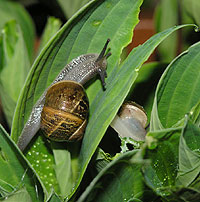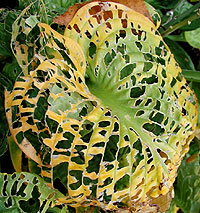Article from the
Weekend Gardener Online Magazine
How
To Kill Snails and Slugs - The Definitive Guide
Introduction:
Snails
and slugs have been the bane of gardeners for generations. And while
over time, many methods have been developed to control these slimy
pests, some methods work better than others.
Our goal in
creating this "Definitive Guide" was to show all the different ways how
to kill snails and slugs, or simply control them, so you can choose
which method, or combination of methods, will work best for you in your
particular garden or situation.
The snail and slug control
methods listed below are not in any particular order, but all of these
methods are organic, except one, (and you'll see its drawbacks when you
read it). The basic fact is that all these methods work to varying
degrees, and after reading this guide, slug and snail control will be
much easier for you, and you'll be able to implement something quickly
and easily, and you won't have any further problems. Won't it be nice
to have healthy, uneaten plants once again!
Quick Identification First
Before
we get started, let's take a quick look at the difference between slugs
and snails which is probably apparent to you, but let's take a quick
look anyway. It is always easier to get rid of a pest when you
understand it, its habits, and its lifecycle.
* Description
Adults are soft-bodied, land-dwelling
mollusks. Snails have coiled
shells on their backs and are 1 to 1-1/2 inches (2.5 to 4 cm) long.
Slugs are without shells. Garden slugs are 1/8 to 1 inch (3 to 25 mm)
long (longer when stretched out); banana slugs may be up to 4 to 6
inches (10 to 15 cm) long. Most slugs and snails are dark or light
gray, tan, green, or black; some have darker spots or patterns. They
leave a characteristic slimy trail of mucus behind them. Eggs are
clear, oval, or round, and are laid in jelly-like masses.
*
Plants Affected
Any tender plant or shrub.
* Damage
Both slugs and snails feed mostly on
decaying plant material. They also
eat soft, succulent plant tissue and rasp large holes in foliage,
stems, fruit, and even bulbs. They can completely demolish seedlings
and severely damage young shoots and plants. Snails, and sometimes
slugs, can climb into trees and shrubs to feed. Both have higher
numbers and cause most damage in wet years, and in regions with moist
conditions, or high rainfall.
* Life
Cycle
Adults lay egg masses in moist soil, or
under rocks or containers, or
garden debris. Eggs hatch in 2 to 4 weeks. Slugs grow for 5 months up
to 2 years before reaching maturity; snails take 2 years to reach
maturity.
|
Snail:
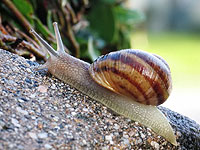
Slug:

Damage:

Eggs:
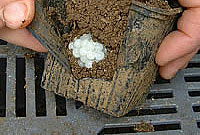 |
1. Hand
Picking
Hand-picking
and disposing of slugs and snails (including stomping on, throwing in
the street, dropping in a bucket of salt water, etc.) does work,
because if you gather up all the adults before they reproduce, things
will get dramatically better, because the tiny ones you miss, don't do
the most damage.
You can do this by day, or go out at night with
a flashlight and gather slugs by hand and drop in soapy water in a
container they can't climb out of.
| Tip:
If you're going to do
this, use chopsticks or tweezers. Doing it with gloves is very
cumbersome, and using your hands leaves a thick slime, so use some
other device to help pick slugs off plant leaves. |
| Note - A
Word About Salt and Salt Water: If you want, you can discard snails or
put them in a bucket of salty water to kill them - but don't put salt
out in the garden directly on the soil, you'll end up ruining your soil! |
|
Hand Picking:
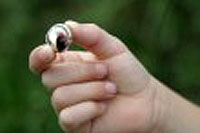 |
2.
Lures and Traps
This
method's goal is to coax snails and slugs out of the flowerbeds into
what they think is a safe haven. In reality, it's a haven you're going
to throw away every day.
You can do this by laying on the ground:
* A flat
board
* Inverted cabbage leaves
* Inverted orange, grapefruit, or citrus rinds
* You can also use an inverted flower pot (prop one edge up slightly)
The
slugs and snails will crawl under these items to get away from the
light, and heat of the sun, and in the morning all you need to do is
dump them into the trash.
Place the pots, boards, cabbage
leaves, or rinds in the garden in the evening and check daily. If pests
are present throw them out, and put out fresh rinds or leaves. Check
traps and destroy pests every morning until numbers drop, then check
weekly.
|
Citrus Rinds:
 |
3. Beer
or Yeast & Honey Mixture
Snails and slugs are attracted to the scent of stale beer or a mixture
of yeast and honey.
* Put
out a saucer filled with stale beer, or the yeast and honey mixture
(listed below)
* Sink it into the ground so the top of the saucer is at ground level
* Slugs and snails will get into the mixture and drown.
Keep
in mind this will only
reliably kill slugs if the trap is deep enough
so that slugs can't reach over the top to get out. So in the case of
slugs, use a deeper trap like a deep yogurt container, or a deep
plastic cup. Something that is too deep for a slug to climb out of, so
it drowns in the beer.
Check the container daily to make sure a
frog or something else hasn't accidentally fallen in, and also to empty
and refill every couple of days.
Yeast & Honey Mixture:
Now,
if you normally don't have beer around, a very effective alternative is
boiling some yeast and honey in water. The proportions aren't very
critical, just mix some up.
Once that is made, continue as
above. Bury a dish up to the rim in your garden and fill it with this
mixture. You’d be amazed at how well this works. The snails
and
slugs will glide right in and drown themselves. We’ve also
heard
old grape juice works well, but we have never tried that.
|
Beer Trap:
 |
4. Dry
Dog or Cat Food
Another good food to lure snails and slugs away from your plants is to
use dry dog or cat food. What you do is:
*
Get a tin foil pie pan and cut a few notches along the rim so that
when you set it on the ground you have created a few "doors" for the
snails to come in
* Pour some dry cat or dog food where you want the snails to come
* Put the tin foil pan upside down and weight it down with a rock
* Next morning, you can scoop up the snails, put them in a bag, and
toss it in the trash
| Note:
If you have a problem with raccoons, skunks, or opossums in your area,
make sure they are not eating the food. If they are, discontinue and
try another method. |
|
Use An Upside Down Foil Pan:
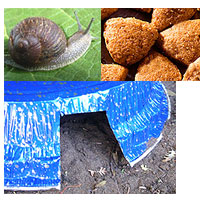 |
5.
Copper Deterrents
Snails
and slugs cannot tolerate copper; it gives them a slight electrical
shock on contact. Knowing this is great, but keep in mind that it
creates a barrier only. It won't kill them, it will only keep them out
of an area that doesn't already have a problem.
This can be very helpful for raised beds, trees, containers, flower
pots, and other areas in your yard or garden.
After
you have applied the copper to the desired area, finish by bending the
exposed vertical strands outward. (see pictures to the right)
| Note:
This works only for slugs if the copper strip or mesh is wide enough so
that slugs can't raise their bodies over it. The majority of copper
stripping sold in garden shops for this purpose is not wide enough to
create an effective barrier, which would need to be 6 to 8 inches (15
to 20cm) wide, or the largest most destructive slugs will hump right
over it without touching the copper. If need be, simply put down a
double layer of banding to make sure it is wide enough. |
Examples
Where Copper Works Well:
Tree
trunks: Apply a copper band around the base
Flower
pots: Apply a copper band around flower pots and they will
not cross it
For
cold-frames or raised beds: Attach copper flashing to the
frames
Greenhouse
benches: Attach 3 inch (7.5 cm) wide copper bands around
edges
Now
obviously, putting a copper barrier around an entire garden is not
going to be practical, but it is an excellent method for protecting
very sensitive seedling beds or small containers.
Copper screen
or copper flashing can surround a raised bed, or for small planters,
copper foil (such as Snail-Barr) can be used to wrap the entire
container. Shrubs can have a band of copper around the lower trunk.
In
order for the copper to continue to work, it needs to be cleaned
periodically with vinegar or it will tarnish and no longer work.
|
Copper on Tree Trunk:
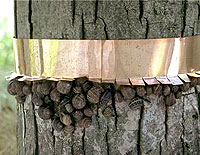
Copper on Flower Pot:

Copper in Garden Bed:

Commercial Product:
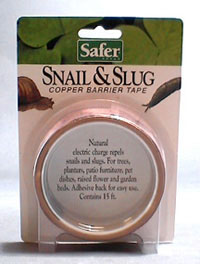 |
6.
Scratchy Things
Scratchy
things such as crushed eggshells, sandpaper, cinders, wood ashes, and
diatomaceous earth (this will need replacing if it gets wet), work well
as a barrier. Again, this method will not kill the snails and slugs,
but it will slow them down.
Another scratchy material they don't
like to cross is sandpaper. You can make sandpaper collars to put
around your plants if you have the inclination.
Cut doughnuts
from sheets of sandpaper, or use used sandpaper discs from orbital
sanders. Cut a slit to the center of each circle, and slip the collars
around the stems, laying the sandpaper discs on the ground. |
Egg Shells:
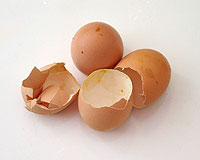
Diatomaceous Earth:
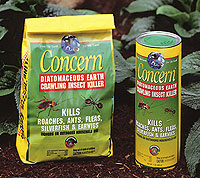
Sandpaper Discs:
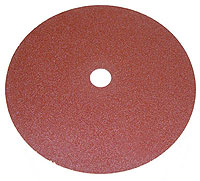 |
7.
Natural Predators
Possums,
chickens, ducks, turtles, tortoises, rats, some birds, and snakes, will
prey on snails and slugs. Most people that have chickens and ducks
hardly ever see a slug or a snail.
Obviously this solution will appeal only to those who live in a rural,
or favorable setting. |
Ducks Love Snails and Slugs:
 |
8.
Predatory Snails
A
predatory snail called a Decollate snail (Rumina decollata) will feed
on young snails and may be worth a try, but they also may nibble on
young plants.
It takes a little time to get an established group of Decollate snails,
but many people have been pleased with the results.
These
snails are semi-tropical and don't thrive in temperate or cold gardens;
and in some places where they would thrive, they are banned as
potentially invasive species.
They are however, physically
attractive snails, and when they do the work effectively for some
gardeners, they should be encouraged to keep doing so.
If you want to try these, make sure to avoid any kind of snail bait,
organic or other, because it will affect these snails too.
|
Decollate Snail:
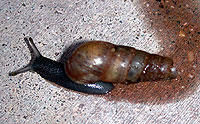 |
9.
Organic Baits
Two
of the best organic snail and slug bait products on the market are
Sluggo and Escar-Go which contain iron phosphate. They are safe to use
around pets, humans, fish, birds, beneficial insects, and mammals.
For
several other organisms, including earthworms and certain ground
beetles, no harmful effects are known. You can also safely use iron
phosphate around food crops, ornamentals, lawns, gardens, greenhouses,
and berry gardens up to the day of harvest.
Iron phosphate is an
organic compound that is found naturally in the soil, and if the bait
is not consumed by a slug or snail, the material breaks down into
fertilizer for your soil. Iron phosphate is not volatile, and does not
readily dissolve in water, which minimizes its dispersal beyond where
it is applied.
It is applied to the soil as a pellet that also
contains bait to attract snails and slugs. When the pests eat the
pellets, the iron phosphate interferes with calcium metabolism in their
gut, causing the snails and slugs to stop eating almost immediately.
They die 3 to 6 days later.
Iron phosphate is more effective
than Metaldehyde-based chemical products (such as used by Ortho)
because Metaldehyde ceases to work when it gets rained on, or if you
water the garden, whereas iron phosphate remains active even with
repeat wettings, for up to 2 weeks.
Some people will argue that
Sluggo and Escar-Go are not as cheap as Metaldehyde-based products, but
this isn't necessarily true, because iron phosphate remains active
longer, so it requires less to be used to kill more slugs, so in fact
it is cost-effective.
What works best is to kill the adult slug
and snail population early in the year before they lay their eggs. If
you do that, you will be slug and snail free for the rest of the year
without further applications.
The best time for long-term
control is to treat the whole garden in the dampness of autumn. That
way, in the spring, there will be very few adult slugs and snails to
lay their eggs. Another application is useful in late winter or early
spring, and again 1 month later. Three applications a year can do the
trick.
How to
Apply:
Iron phosphate products are used the
same as other bait materials. Simply scatter the granules over the
soil's surface, (do not place in piles), where snails and slugs feed.
If the ground is dry, wet it before applying bait. The soil should be
moist but with little or no standing water.
Once
the slugs have eaten the bait, they immediately stop eating and crawl
back under the plants to die. Iron phosphate is slower acting than the
synthetic metaldehyde, but is active on the soil surface longer that
other baits, and when ingested, the slug stops damaging your plants,
which is the whole idea.
Some
Basic Facts:
Sluggo and
Escar-Go have a powerful lure that slugs and snails find irresistible.
Repeated studies have shown that slugs and snails will eat these baits
before they will eat nearby plants.
Iron phosphate disposes of
snails and slugs without mess. You may not see the dead slugs and
snails in your garden because they often crawl away to secluded places
to die. But you will notice that your plants are no longer being eaten.
Iron
phosphate controls in hard-to-reach areas. because it actually lure
snails and slugs from their hiding places, which provides control in
any area that slugs frequent, even in mulched beds.
The
only
thing beneficial that would be harmed by iron phosphate
would be
predatory, snail-eating, decollate snails (mentioned above in number
8). If a garden does have these predatory snails, do not use iron
phosphate or any other bait.
|
Sluggo:
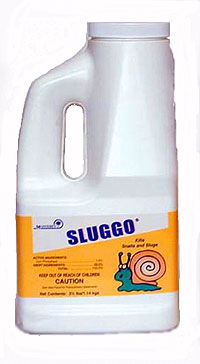 |
10.
Chemical Baits
Methaldyhde-based
baits - A word of caution if you have been using a pelleted form of
snail bait; it can be dangerous around pets as it looks like food to
them. The finer granule type is much safer - but please be careful and
read the label and use as directed.
Slug and snail baits with
Metaldehyde are sufficiently toxic that such baits are not recommended
for use around edible vegetables, and can be harmful to dogs, cats, and
fish.
Baits with Metaldehyde work differently than the organic
ones with iron phosphate, and since we have already given great detail
about how iron phosphate works above in number 9, let's look at
Metaldehyde.
Metaldehyde poison dehydrates the snail or slug
rather rapidly if it eats the poison. That is a good thing, but slugs
and snails can recover from Metaldehyde poisoning if there is rainfall,
or access to wet locations, where they will not fully dehydrate and die.
A
slug can lose half its body weight and shrink to a third its size from
Metaldehyde poisoning, or by covering it in salt, but if it can get
itself to wet soil fast enough, or if it rains, it will recover.
Because
Metaldehyde by itself sometimes isn't as effective as it could be, some
products like Ortho Plus include carbaryl to increase its toxicity.
Carbaryl kills beneficial insects and therefore should be used with
caution.
Another drawback is that after being dampened,
Metaldehyde products no longer work, so that means every time you
water, or it rains, you will need to re-apply it.
Many chemical-based baits do work, but be careful how and where you
apply them.
|
Metaldehyde Snail Baits:
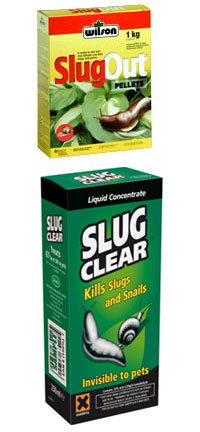 |
11.
Coffee Grounds
The
alleged method of slug control using old coffee grounds, we think,
amounts to gardening folklore because we have found it doesn't work
very well.
If, however, you are a person who uses this method
and swears by it, by all means continue! No sense in stopping something
that works for you.
|
Coffee Grounds:
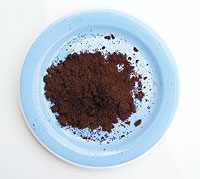 |
12.
Spray With Vinegar and Water
Mix
equal parts vinegar and water. We have never tried this, but many
people have sworn that spraying this mixture on snails and slugs solves
the problem for them. |
Vinegar:
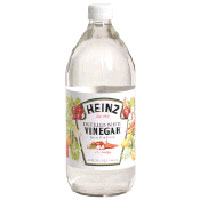 |
13.
Herbal Repellent
Putting
mint or sage in your mulch is reported to do a good job of repelling
them. We have never tried this, but many people have sworn by using
this mixture to repel slugs and snails. It won't kill them; apparently
it just acts as a barrier. |
Mix in Herbs:
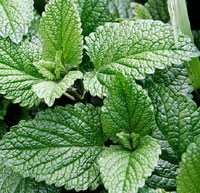 |
If we
have missed any, please let us know!
We have tried to be as all-inclusive as possible of all snail and slug
barriers, repellents, and toxins.
There
is however, always another idea out there, and if we have not included
it on our list, please let us know. We always welcome any feedback.
Contact Us at
weekendgardener.net. Any additional information sent in
will be posted below.
Overall, we hope you have found our "Definitive Slug and Snail Guide"
helpful and useful. |
Snail
Damage:
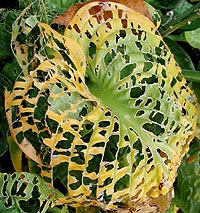 |
Back to
Fruit
General Page
How to Index Page
|
Copyright WM Media. All rights reserved.
This work is licensed under a Creative Commons Attribution-NoDerivs 2.5
License.
|
